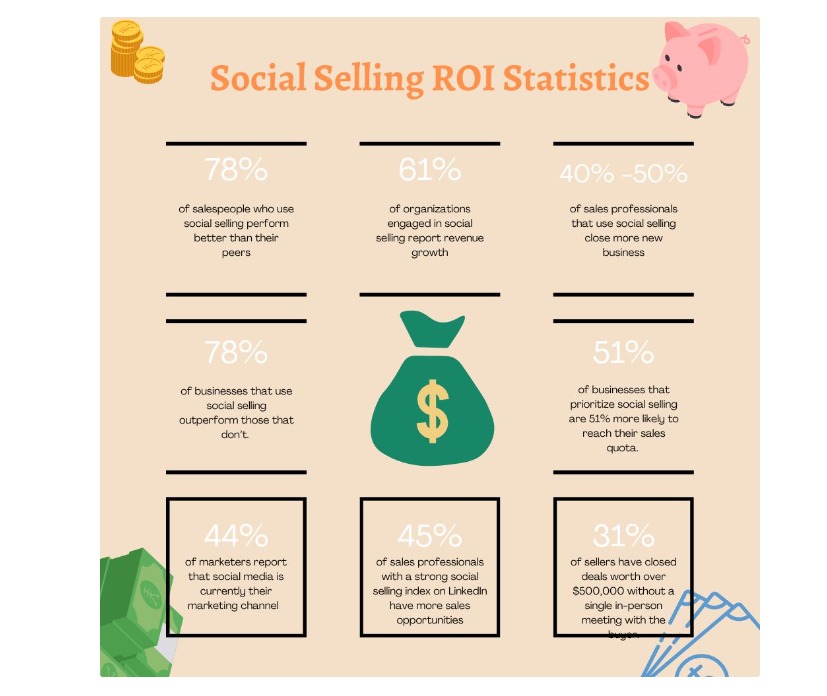Meta is testing selling their verification badge for $12 a month for Facebook and Instagram. Twitter Blue is already available for at least $84 a year. And, individuals and businesses will pay for these badges for their social media pages.
As the saying goes, “If you’re not paying for it; you are the product.”
Research shows that more than half the world’s population uses social media— that’s 4.62 billion people.
LinkedIn reports that individuals and businesses using social selling on the platform outperform their peers by 78%. The number may vary on other platforms, but it’s a clear indication that social selling works—that’s why we’ll pay for that Twitter blue and stamp some authority to our brands.
Social selling is using social media to build trust and credibility among our potential customers.
Today, we’ll look at how social selling works and how you can create an effective social selling strategy for your business or brand.
How Does Social Selling Work?
Social selling involves using social media networks and building relationships with potential customers, establishing credibility, and ultimately prompting customers to buy from you.
The first step to successful social selling is identifying your target audience. This is a group of prospective customers with similar challenges, interests, and needs. Identifying your ideal customer helps you create an effective strategy for reaching them.
With your target audience in mind, find out where they hang out on social media— the platform where they’re more active. This acts as a guideline on what kind of content you need to produce and the social selling tool to use.
For example, a fitness coach is better off creating workout routines on YouTube and building a fitness community, while SaaS sales reps will thrive on LinkedIn. Sharing expertise and insights on the right platform helps you build relationships with potential clients that you can easily convert into actual customers.
Here’s an example of a fitness coach who has built a community on YouTube and Instagram.

The Four Pillars of Social Selling
Social selling is a multifaceted approach centered on building customer relationships through social media. Here are the four crucial pillars of social selling:
- Branding- A strong personal brand helps you portray a specific image online. It helps customers identify your business’s values, expertise, and personality. Personal branding helps you run a business as a solopreneur and gives you credibility as a founder.
- Identifying the right target group- You cannot sell to everyone or a random person. You must know whom you want to sell to and why. Identify a group that can benefit from the solutions you offer and tailor your content and approach to their needs.
- Fostering relationships founded on trust– After providing valuable content to your target customers, build trust by allowing them to review your products, return damaged goods, request refunds, and recommend your products. This creates a level of transparency and honesty that can establish long-term relationships with customers.
- Sharing engaging insights– Social media is a highly competitive space, so it’s crucial to make your content stand out by sharing tips, tricks, and unique resources that provide value to your audience. By creating engaging content, you can attract and retain customers, build brand loyalty, and increase sales.
- Listening to your target audience– Listen to your target audience’s feedback and address their concerns. This helps you understand their needs and tailor your social selling strategy to meet those needs.
Benefits of Social Selling
Social networks provide businesses with various social selling tools, such as LinkedIn’s Social Selling (SSI) tool, to monitor their selling metrics.
76% of sales managers successfully implement social selling and recommend prospect research for better results. For success, ensure your sales teams know social selling best practices and how to use vital tools such as LinkedIn sales navigator.

Credit: Hubspot
Let’s look at why social selling is an important pillar of your content marketing strategy.
1- Enhances the trust customers have in your business
Customers tend to buy from businesses they trust due to their active social presence. Social presence indicates transparency, making buying easier because customers feel safe buying from your business.
2- It allows you to understand your customers better.
Even when your social selling funnels do not generate sales conversations or face business challenges, you better understand the customers’ needs through the data they collect.
Social media data and insights help you create a working strategy that generates leads and sales for your business.
3- Gives your business long-standing rewards
Customer loyalty is the ultimate reward of social selling. You invest time and effort to help your customers navigate your products, and they sustain your business by opting for your products compared to the competitor’s products.
How to Create a Social Selling Strategy
Different social media platforms work differently. For example, Facebook focuses on connecting family and friends, while LinkedIn focuses on employment credibility.
Your goals and objectives will determine the right selling strategy for your business. Here is how to go about it:
- Identify your target audience — your ideal customer and the social media platform they use most. Use demographic data such as age, gender, and location to narrow down to the ideal person.
- Choose the right social media platforms and create a profile on each platform you plan to use.
- Build your social media presence– optimize your profiles by using high-quality images, writing compelling bios, and including your contact information.
- Engage, engage, engage– Respond to your followers’ comments and messages to build an intentional relationship.
- Take advantage of social media advertising– This will help you reach new audiences and promote your products or services.
- Measure your results with metrics such as engagement, reach, and conversion to see how well your social media strategy is performing.
Common Social Selling Strategies
As you connect with potential leads on social media and ultimately drive sales, here are unique social selling strategies you can use.
1- Scripted selling strategy
A scripted selling strategy is a sales technique where a salesperson follows a pre-determined script or set of talking points during a sales conversation with a potential customer.
In a social selling context, you can create scripts that will be used to answer any questions your audience raises.
2- Consulting selling strategy
With a consulting selling strategy, you position yourself as a consultant— the go-to person for your customers’ needs.
In social media, you can engage in a dialogue to provide a deep understanding on your industry, customer concerns and products.
To succeed in consulting selling strategy, ensure you portray expert knowledge in all the insights and guidance you provide.
3- Need-satisfaction selling strategy
This sales approach focuses on identifying and addressing your customers’ specific needs and desires. The goal is to “sell” your product or service as the perfect solution.
The need-satisfaction selling strategy is particularly effective when the customer is actively looking for a solution to a certain problem.
To execute this strategy, devise ways to get your social media audience to explain their needs For example; you can create incentivized surveys to understand their needs and proceed to create content that satisfies their needs.
4- Strategic partnership selling
This is a strategy best suited to business-to-business social selling. You partner with another business to share resources and information to keep both businesses going.
A social selling program involves putting a social selling master plan into action. Programs allow you to monitor the effectiveness of the selected strategy and look for ways to scale it.
How to Implement Social Selling Effectively
Once you have a defined social selling strategy, here are tips on how you can implement it:
- Define your strategy- Who is your audience, which social media platform do they use, and what kind of content appeals to them?
- Engage with your audience- Social selling is about building meaningful relationships through constant engagement.
- Create a consistent schedule- Define how often you’ll be posting your content.
- Look for social selling opportunities frequently- Focus on growing your audience and introducing new products and ideas. For example, with a significant following on LinkedIn, you can create a course and promote it to your community.
The Key Elements of Social Selling
The five key elements of social selling help you subtly include social selling in your marketing strategy effortlessly. They include:
Influence sphere
The influence sphere explains the need to approach relevant groups of interest through a particular category of people you know. This concept is most useful in B2B digital selling on platforms such as LinkedIn.
For example, if you want access to a specific decision-maker, you start by approaching the network of people you know and asking them to pass your message. When you join LinkedIn groups, you will have access to several people to network with.
Social proximity
Social proximity refers to the level of closeness or familiarity between two individuals within a social network. In social selling, social proximity allows you to build relationships with potential customers by leveraging existing connections, networks, and relationships.
You have a greater chance of successfully sharing with social friends and acquittances because they feel they trust you.
Buying triggers
Sometimes, social media users leave behind information that signals that your business should start social selling. This set of information is referred to as buying triggers. Triggers can be soft or hard.
Soft triggers are indirect, such as monitoring a group of mothers speaking about naming their kids because your business sells baby products.
Hard triggers are direct. For example, when you spot a potentially new customer inquiring about the prices of your products. Relationship building begins when you step in and provide the required information.
Buyer 3.0
Buyer 3.0 refers to the modern social media buyer who must go through reviews and several pieces of information before deciding or giving a business a chance. To approach such a group socially, you must know how to study their behaviors and interaction patterns.
Social surrounding
Social surrounding refers to doing a 360-degree study of a business’s prospects before developing a strategy to approach them. You take time to understand what the prospect does professionally and how they run their life, all through social media channels.
Using the social surrounding approach does away with the need to start building rapport when cold calling because you already know enough information to sell your business socially.
Social Media and Selling
Social media has revolutionized the way we do business.
It offers a unique opportunity to engage with customers on a personal level, build relationships, and increase sales.
But the real power of social media lies in its ability to provide both organic and inorganic marketing opportunities.
Gone are the days when businesses had to rely solely on traditional advertising methods to get their message out there. Social media platforms like Facebook, Instagram, and Twitter have made it possible to connect with potential customers in ways that were never before possible.
Whether through direct messaging, instant messaging, social groups, or communities, social media has become a powerful tool for generating leads and converting them into sales.
Recap of Key Takeaways
Social media offers a wide reach of potential customers you can quickly engage and create a relationship.
- Social selling is the process of interacting with customers on social media platforms to build relationships.
- The four pillars of social selling will help you create a successful social selling setup.
- There is a wide array of social selling strategies you can come up with based on the platform you select.
- The five critical elements of social selling enable you to find the best approach to social selling.
Let’s help you grow your business on social media with great sales-enabled content. We understand social selling and how to scale up a business affordably. Get started now.

